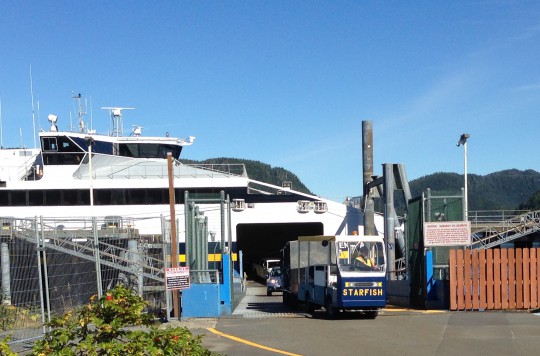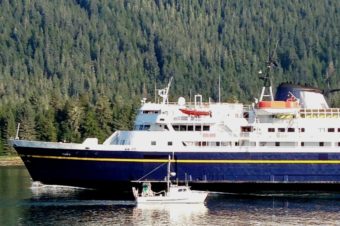
A baggage cart leaves the Chenega after docking in Sitka in 2015. The fast ferry is being tied up in Tacoma, Washington, for the immediate future. hoto by Ed Schoenfeld/CoastAlaska News)
The Alaska Marine Highway System is paying more than $1,200 a day for long-term storage of two unused ferries. One critic says it would be better to sell them than to tie them up.
The state has awarded contracts totaling more than $450,000 to tie up the ferries Taku and Chenega for the next year.
The ferry system already docks a number of ships each winter when lower passenger numbers drop the demand. But this is different.
Spokesman Jeremy Woodrow says they’re being completely shut down and emptied of fluids. He says the Taku is being towed to a storage site in Ketchikan’s Ward Cove. The Chenega is headed to the Vigor Shipyard in Tacoma, Washington.
“The vessel will be unmanned. That’s part of the cost. The company will be in charge of the vessels’ keeping,” he said.
Ferry managers have a clear take on the future of the Taku. They plan to sell the 50-year-old mainline vessel, which can hold up to 350 passengers and 50 cars or trucks.
But Woodrow says that will take a while.

The ferry Taku sails into the Wrangell Narrows on its way south in 2014. It’s since been pulled out of service and is being stored until it can be sold. (Ed Schoenfeld/CoastAlaska News)
“It’s not just listing it on eBay tomorrow. There is a process to go through procurement and we’re working on that process,” he said.
EBay is how the Bartlett, a smaller ferry, was sold in 2003.
The Chenega’s future is less clear. It’s much younger, beginning service only 11 years ago. It has a smaller capacity: 210 passengers and about 30 vehicles. And unlike the Taku, it has no staterooms or full-service cafeteria.
The Chenega and its sister ship, the Fairweather, were designed to provide faster, shorter sailings that some predicted would be the future of the marine highway system.
“No discussion of selling or of retiring the Chenega at this point or either of the fast ferries. The only ship we’re looking at now is the Taku,” he said.
“It doesn’t make any sense,” said Petersburg’s Dave Kensinger, who owns a regional produce business that depended on the ferry system before service cuts made it impractical.
He’s also a member of a committee coming up with a new Alaska Marine Highway System management structure.
“We don’t have enough money and we probably won’t have enough money in the future to maintain and operate the fleet that we currently have. So, at some point you just have to cut your losses,” he said.
He likes the fast ferries. But he says their fuel and maintenance costs are just too high.
“If you gave me a choice between riding in a Volkswagen or riding in a Maserati, yeh, I’d love to ride in a Maserati. But, guess what? If you gave me those vehicles, I couldn’t afford to even put the gas in a Maserati, let along pay the maintenance bill for it,” he said.
The new committee he’s on was set up by the marine highway and the Southeast Conference. That’s a regional development group that pushed to build the first ferries back in the 1950.
It’s looking at different models for running the system. That includes researching other ferries and how they’re governed.
“That’s how transportation’s run all over the free world. It’s not directly operated by the executive (branch). You don’t have the mayor running the bus system. You don’t have governors running rail systems or ferry systems in most other places in the world,” he said.
The one-year, $450,000 price for tying up the Taku and Chenega includes some towing and set-up costs. Future years, if they’re needed, will cost about 25 percent less.
And Woodrow says the storage fee will be prorated when one or both ships are sold or returned to service.





